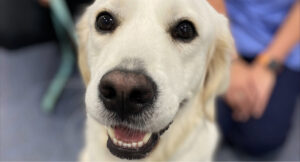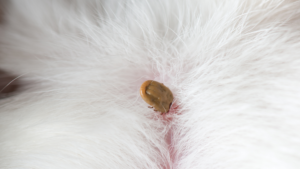What are Anal Sacs?
Anal sacs, also known as anal glands, are two small sacs of glandular tissue located under the skin on both sides of the anus in both dogs and cats. They are located approximately at 4 and 8 o’clock. They produce secretions that have a pungent smell and are used to mark and provide olfactory cues to other animals. There is a duct that connects the sac to the rectum and the secretion comes out with stools when the pet passes faeces, but it can also sometimes come out when the pet is excited or alarmed! The secretions from these glands can have a wide range of appearances and odours (none of which are good to the human nose).
The sacs can become irritated and inflamed for a variety of reasons and the duct can become blocked. This results in a variety of anal sac conditions ranging from minor irritation to impaction and abscessation. Tumours can also form in the anal sacs.
Who is affected?
Both cats and dogs can suffer from conditions affecting the anal sacs. Some breeds seem to be more predisposed to anal sac disorders; however, it is unknown as to whether this is due to concurrent allergies, genetics, or due to their anatomical conformation.
According to PetSure data across the 2020 calendar year, anal sac conditions are most prevalent in the following breeds:
| Breed | Prevalence |
| Cavalier King Charles Spaniel | 6.29% |
| Tibetan Spaniel | 4.36% |
| Cavoodle | 3.42% |
| Spoodle | 3.38% |
| Toy Poodle | 3.36% |
| Boston Terrier | 3.34% |
| Shih Tzu | 3.28% |
| Cocker Spaniel | 3.17% |
| Maltese | 3.11% |
| Bichon Frise | 3.09% |
Prevalence = Total number of unique claiming pets / total number of insured pets across 12-month period. Excludes breeds with less than 500 active pet insurance policies.
Signs of Anal Sac disease
One of the most common signs of anal sac disease occurs secondary to irritation of the area and is colloquially referred to as “scooting”, where the pet drags his or her bottom along the ground (or more likely your favourite rug or expensive carpet!).
Other signs of anal sac diseases include:
- Straining to pass stools
- Chewing and biting around the rear end
- Swelling around the anus
- Blood, pus, or redness around the anus
- Reluctance to sit
- Matted fur around the bottom
- Crying and whimpering, signs of pain or irritation
- Lethargy, inappetence, and signs of systemic illness
- Unpleasant odours on furniture or arising from your pet (sometimes may have “fishy” or metallic notes)
Management of Anal Sac diseases
As there is a range of diseases affecting the anal sacs, the treatment will depend on the type and cause of the problem.
Blocked ducts or anal sac impaction may be alleviated with frequent anal sac expression at the Vet or at home under Veterinary guidance. Increasing fibre in the diet may facilitate drainage of the ducts. Some pets with concurrent allergic skin disease may require treatment for this underlying condition to help reduce inflammation in the glands. It is important to regularly check the anal sacs in pets who have had impacted glands to help prevent further blockages and subsequent pain and irritation. In some cases, an anaesthetic may be recommended to flush and drain the sacs and ducts.
In cases of abscessation, lancing and draining the affected area may be required, along with antibiotic therapy and pain relief. Antibiotics may need to be inserted into the sacs to ensure that they are able to target the area appropriately. Again, these pets should have frequent monitoring of the sacs to ensure they do not form abscesses again.
Pets with recurring anal sac impaction or abscessation may benefit from surgical removal of the sacs. Your Vet will be able to recommend the best treatment for your pet.
Tumours are also typically treated with surgical removal and provided the cancer has not spread to other areas of the body; this can be curative.
To manage a reoccurring disorder appropriately, blood tests may be required to rule out any underlying diseases first. Additionally, other adjunctive treatments may be appropriate, such as anti-inflammatories or a diet change.
How much does it cost to treat?
According to PetSure claims data from the 2020 calendar year, the average, single treatment cost relating to anal sac diseases is $147 and the highest, single treatment cost was $5,165.
Are Anal Sac Disorders covered by pet insurance?
Anal Sac Disorders may be covered by Comprehensive Accidental Injury and Illness pet insurance policies administered by PetSure (check our brand partners at petsure.gholab.com.au/partners), unless related to a pre-existing condition or exclusion. Please refer to your policy documents including Certificate of Insurance and Product Disclosure Statement (PDS) for more information on whether this condition is covered under your policy.
Disclaimer: Reimbursement for these claims would be subject to limits, such as annual benefit limits or sub-limits, benefit percentage, applicable waiting periods and any applicable excess. Cover is subject to the policy terms and conditions. You should consider the relevant Product Disclosure Statement or policy wording available from the relevant provider.
REFERENCES
- Radhakrishnan, S 2020, Anal glands and anal gland abscess in dogs, Veterinary Information Network, accessed 30th August 2021, https://veterinarypartner.vin.com/default.aspx?pid=19239&id=9759085.
- Grossman, M 2021, Anal sac, revised 6th July 2017, Veterinary Information Network, accessed 30th August 2021, https://www.vin.com/members/cms/project/defaultadv1.aspx?id=5612395&pid=11200&.
Pet insurance can help by covering a portion of the eligible vet bill if the unexpected happens. Because it is difficult to predict the costs of veterinary care, it can help to have measures in place to help prepare for the unexpected. Check out our partner network and explore our policy tools to find a pet insurance policy.
Not all conditions or items are covered by Pet Insurance. Refer to the applicable Product Disclosure Statement for information about coverage and exclusions.








